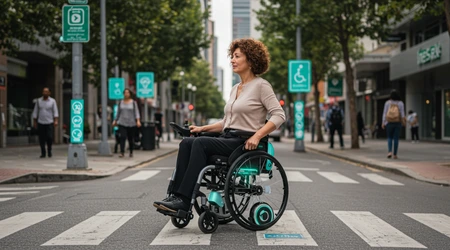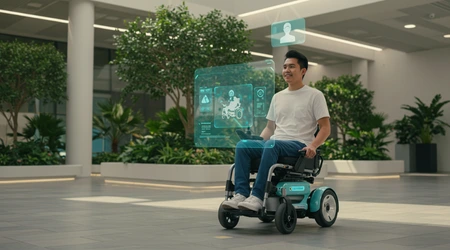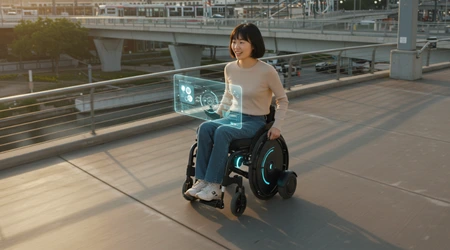The Future of Smart Wheelchairs: What’s Coming Next

The future of smart wheelchairs is unfolding with remarkable speed, driven by cutting-edge technology and a growing focus on inclusivity.
These advanced mobility devices are no longer just about getting from point A to point B; they’re becoming intuitive, adaptive systems that empower users with greater independence and comfort.
From AI-driven navigation to exoskeleton integration, the innovations shaping the future of smart wheelchairs promise to redefine accessibility.
This article explores the latest trends, real-world applications, and transformative potential of these devices, grounded in current advancements and practical examples.
Why settle for outdated mobility solutions when the future of smart wheelchairs is already here?
Assistive technology is evolving rapidly, and wheelchairs are at the forefront of this revolution. Recent showcases, like CES 2025, highlighted hands-free wheelchairs and AI-powered controls, signaling a shift toward smarter, user-centric designs.
The global wheelchair market, valued at $6.2 billion in 2022, is projected to grow as innovations address diverse user needs.
This piece dives into the technologies shaping the future of smart wheelchairs, offering a glimpse into how they’ll transform lives with precision and care.
AI and Autonomous Navigation: A New Era of Mobility
Imagine a wheelchair that anticipates your destination and navigates obstacles effortlessly. AI is making this a reality in the future of smart wheelchairs.
Machine learning algorithms now enable wheelchairs to map environments and avoid hazards in real time.
For instance, the Naqi Neural Earbud, showcased at CES 2025, allows users to control wheelchairs using head gestures, offering a non-invasive alternative to brain implants.
These systems learn from user patterns, adapting to preferences over time. A wheelchair might detect a crowded room and reroute smoothly, enhancing safety.
++ How Haptic Feedback Enhances Accessibility in Gaming
Such autonomy empowers users with limited motor function, like quadriplegics, to navigate with confidence. The technology mirrors self-driving car systems, but tailored for personal mobility.
Beyond navigation, AI personalizes user experiences. Smart wheelchairs can adjust seat positions or monitor health metrics, ensuring comfort and safety.
This blend of autonomy and customization is setting a new standard for assistive devices, making the future of smart wheelchairs both practical and transformative.

Lightweight Materials and Enhanced Durability
The quest for better mobility drives material innovation in the future of smart wheelchairs. Carbon fiber and graphene are replacing heavy steel frames, reducing weight significantly.
Lighter chairs improve maneuverability, allowing users to travel longer distances with less effort. These materials also boost durability, resisting wear in diverse environments.
For example, flexible spoke tires, highlighted at CES 2025, offer a smoother ride and lower maintenance compared to traditional designs.
This innovation reduces the physical strain on users, particularly on uneven terrain. Such advancements make wheelchairs more reliable for daily use.
Also read: How Brain-Computer Interfaces Empower People with Paralysi
Energy efficiency ties into material advancements. Lightweight frames paired with advanced batteries, like those inspired by EV technology, extend range.
Users can now rely on their chairs for extended outings, confident in their durability and performance.
Exoskeleton Integration: Blending Mobility and Strength
What if a wheelchair could help you stand or walk? The future of smart wheelchairs includes exoskeleton integration, blending mobility with physical support.
These hybrid systems, like the Bio Leg showcased at CES 2025, assist users with partial mobility in standing or walking short distances.
Exoskeletons embedded in wheelchairs use AI to predict movement, offering subtle assistance to joints.
For example, a user hiking a trail could receive a boost to their gait, reducing fatigue. This technology empowers users to engage in activities previously out of reach.
Read more: Open Source Assistive Devices You Can Build at Home
Moreover, exoskeletons enhance rehabilitation. Physical therapists can use these chairs to support gradual mobility recovery, tailoring assistance to individual needs.
This fusion of wheelchair and exoskeleton technology marks a bold step toward versatile assistive solutions.
Connectivity and IoT: Smart Wheelchairs as Ecosystems
Smart wheelchairs are becoming hubs of connectivity, integrating with IoT ecosystems to enhance functionality.
The future of smart wheelchairs lies in their ability to sync with smart homes or health apps. For instance, a wheelchair could adjust home lighting or alert caregivers to health changes via connected sensors.
Real-time data sharing is a game-changer. A wheelchair might detect a user’s heart rate spike and notify a doctor instantly.
This connectivity ensures proactive care, especially for users with complex medical needs. It’s like having a personal assistant embedded in your mobility device.
Integration with urban infrastructure is another frontier. Smart wheelchairs could communicate with traffic systems to optimize routes, ensuring safer travel.
This interconnected approach makes the future of smart wheelchairs a cornerstone of smart cities, fostering inclusivity.
Sustainability and Energy Efficiency
Sustainability is shaping the future of smart wheelchairs, with eco-friendly designs gaining traction.
Advanced batteries, inspired by EV innovations like BYD’s flash charging, offer longer ranges and faster charging. These batteries reduce environmental impact while ensuring reliability for users.
Solar-powered wheelchairs are emerging as a practical solution. Panels integrated into chair frames can harness sunlight, extending battery life for outdoor use.
This innovation is ideal for users in sunny regions, cutting reliance on traditional power sources.
Recyclable materials, like biodegradable composites, are also being explored. These designs lower the carbon footprint of manufacturing, aligning with global sustainability goals.
The result is a wheelchair that’s both user-friendly and planet-friendly, redefining mobility with purpose.
User-Centric Design: Prioritizing Comfort and Control

The heart of the future of smart wheelchairs lies in user-centric design, focusing on comfort and personalization.
Adjustable seating systems now use AI to adapt to body posture, reducing pressure sores. For example, a user named Maria could have her chair auto-adjust for long work hours, enhancing comfort.
Voice and gesture controls are becoming standard. The MouthPad^ by Augmental, a CES 2025 honoree, lets users control wheelchairs with tongue movements, offering intuitive operation.
This empowers users with severe mobility limitations to interact seamlessly.
Customization extends to aesthetics. Manufacturers now offer modular designs, allowing users to choose colors or accessories.
This personal touch fosters a sense of ownership, making wheelchairs not just tools but extensions of identity.
Table: Key Innovations in Smart Wheelchairs (2025)
| Feature | Description | Impact |
|---|---|---|
| AI Navigation | Real-time obstacle avoidance and route planning | Enhances safety and independence |
| Lightweight Materials | Carbon fiber and graphene frames | Improves maneuverability, durability |
| Exoskeleton Integration | AI-assisted movement support | Enables standing/walking |
| IoT Connectivity | Syncs with smart homes and health apps | Proactive care, seamless integration |
| Sustainable Batteries | Fast-charging, eco-friendly power sources | Longer range, reduced footprint |
Accessibility and Affordability: Bridging the Gap
Cost remains a barrier, but the future of smart wheelchairs is tackling affordability head-on.
Innovations in scalable manufacturing, like 3D-printed components, are driving down production costs. This makes advanced wheelchairs more accessible to diverse populations.
Insurance and government programs are adapting too. In 2025, policies in countries like the UK are expanding coverage for assistive tech, inspired by initiatives like Innovate UK.
This ensures more users can access cutting-edge mobility solutions.
Community-driven solutions are also emerging. Open-source designs allow local makers to produce affordable smart wheelchairs, especially in underserved regions.
This grassroots approach democratizes access, ensuring no one is left behind in the mobility revolution.
Challenges and Ethical Considerations
Innovation brings challenges, and the future of smart wheelchairs is no exception. Data privacy is a concern, as connected wheelchairs collect sensitive health information.
Robust encryption and user consent protocols are critical to protect users.
Ethical design is another hurdle. Developers must ensure wheelchairs cater to diverse disabilities, avoiding one-size-fits-all solutions.
For instance, a visually impaired user like John needs audio feedback, not just visual interfaces, for effective use.
Regulatory frameworks must keep pace. Governments need to standardize safety protocols for AI-driven wheelchairs to prevent malfunctions.
Balancing innovation with accountability will define the success of these advancements.
Real-World Impact: Stories of Transformation

Consider Sarah, a 32-year-old artist with cerebral palsy. Her AI-powered wheelchair navigates her studio, adjusting to her posture for comfort.
This allows her to focus on painting, boosting her creativity and independence. The future of smart wheelchairs is about enabling such stories.
Another example is Tom, a veteran using a wheelchair with exoskeleton support.
He can now stand to greet his kids, a small act that restores dignity. These innovations turn daily challenges into opportunities for connection.
Statistically, 1 in 6 people globally lives with a disability, underscoring the need for inclusive tech. Smart wheelchairs are not just gadgets; they’re lifelines, reshaping how users engage with the world.
The Road Ahead: What’s Next for Smart Wheelchairs?
The future of smart wheelchairs is poised for exponential growth, blending AI, IoT, and sustainable design.
Next-generation models will likely integrate augmented reality, projecting navigation cues for users. This could transform how users interact with complex environments, like busy airports.
Collaboration is key. Partnerships between tech giants like Nvidia and assistive tech startups are accelerating innovation.
These alliances ensure that cutting-edge AI and hardware reach wheelchair users faster, driving widespread adoption.
Ultimately, the goal is empowerment. By prioritizing user needs, affordability, and ethical design, the future of smart wheelchairs will create a world where mobility is no barrier.
The journey is just beginning, but the destination is clear: a more inclusive future.
Frequently Asked Questions
What makes smart wheelchairs different from traditional ones?
Smart wheelchairs use AI, IoT, and advanced materials to offer autonomous navigation, connectivity, and personalized comfort, unlike traditional manual or basic electric models.
Are smart wheelchairs affordable for most users?
While costs are high, 3D printing and policy changes are improving access. Programs like Innovate UK are expanding coverage for assistive tech.
How do AI-powered wheelchairs ensure safety?
AI systems detect obstacles and adapt routes in real time, while robust encryption protects user data, ensuring both safety and privacy.
Can smart wheelchairs integrate with smart homes?
Yes, IoT-enabled wheelchairs sync with home systems to control lighting, doors, or health apps, creating a seamless user experience.
What’s the environmental impact of smart wheelchairs?
Sustainable batteries and recyclable materials, like biodegradable composites, reduce the carbon footprint, aligning with eco-friendly mobility solutions.
This vision of the future of smart wheelchairs is like a bridge, connecting users to a world of possibilities with technology as the foundation.
By embracing innovation, we’re not just building better wheelchairs we’re crafting a future where everyone can move freely.
